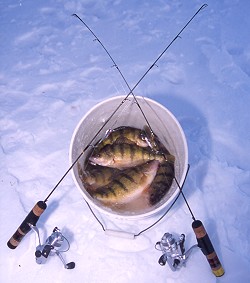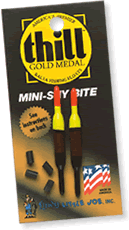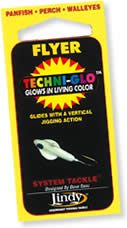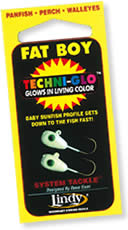Years ago when anglers asked me about ice fishing, my standard reply was “I didn’t do it because I couldn’t master the art of casting into those small holes.” But
While ice fishing definitely fills a void and is as challenging as open water angling, it also supplies as with some of the sweetest fillets a person would ask for. If your taste buds are up for a challenge, fry fillets in Cajun-style breading, then dip each fork full into a pile of blue cheese dressing and then “buffalo wing” sauce before popping them into your mouth. You’ll be planning your next trip very soon.
Basic Movements of Fish
Some of the best ice fishing usually occurs during “first ice.” As the name implies, this is when the ice becomes safe enough to walk on. I know a few avid ice anglers who are slight in build (and gray matter in their heads) who venture out over wafer thin ice, and generally fall through at least once a year. But they are savvy enough to fish in pairs, plus carry ropes and giant nails to help pull themselves out of the water. I wait until the ice gets 3-4 inches thick, and even then tend to fish over the shallower flats during the beginning of the season.
First ice may occur numerous times, especially if you live in the southern third of the ice fishing range where warm fronts cause frequent thaws. Each time the ice gets thick enough to fish, panfish move into shallower, first-to-freeze areas. Sloughs canals, ditches—any type of backwater areas off a lake or river—can harbor droves of these tasty panfish. Slow-tapering shorelines on lakes can be very productive, especially if cover exists on the flats.
As winter progresses and the ice gets thicker, a panfish exodus to deeper water occurs. Pockets or holes in deeper weeded areas, deep weedlines, drop-offs, plus off-shore humps, bars, and points can all be productive, plus schools of suspended panfish can often be found with electronics. In shallower bodies of water, mid-winter panfish, especially bluegills and perch, can often be located smack dab on the bottom in the deepest sections of the lake.
During late winter, a time when the weather begins to warm and the ice begins to weaken, my ice fishing efforts drop dramatically. Fishing can be exceptional, but weak “black ice” makes me generally opt for the open waters in rivers. When I do get out, hot action is generally encountered on the flats just outside panfish spawning areas. Excellent results are often experienced in the 3-8 foot depths, especially very early or late in the day.
Hole Jumping Strategy
Once a specific area is targeted to fish, I usually drill between 8-15 holes. A power auger is the ultimate drilling tool, but a good, sharp hand auger will do the job, especially if the ice isn’t super thick. Two excellent hand augers are “The Edge” by H.T. Enterprises, and Strike Master’s “Laser” model. Both these augers will cut through the ice in a few seconds.
After the holes are cut and the chipped ice is removed with a skimmer, I’ll start fishing, first working the earlier drilled holes. The object is to eliminate unproductive holes and find the ones that produce even a fish or two. When starting to fish in early morning when the “hot bite” should occur quickly, holes will generally be drilled in pairs. This is because I don’t want to be drilling next to a hole that’s producing fish during prime fishing time.
If starting to fish in mid-day in anticipation of a late afternoon to dark bite, holes will be more singularly scattered about. Once I make the rounds and fish all the holes once or twice, the productive ones will be noted. It would be common to catch a least a fish or two out of 2 to 5 holes. The plan would then be to quickly drill another hole next to each productive hole so two rods can be fished. This would be done well before the prime late afternoon to dusk hours, allowing the immediate area time to settle down after the drilling.
I wouldn’t give up on all the holes that didn’t initially produce, and would periodically try them again. A couple things to consider. If a few of the unproductive holes were right into thick areas of weeds, I’d put a long stick or hand auger as far down into the hole as possible and make several big circles with it. This will create a hole in the weeds, and stir up the area, often attracting fish within minutes. Also if holes in 8-10 feet if water were productive during the mid-day hours and holes over shallower were not, re-fish the shallower area if the action comes to a halt in the 8-10 foot range, Sometimes the fish simply move in shallower.
During the last 45 minutes before total darkness, stay on the holes that were producing best earlier in the day. Numerous times I’ve seen anglers dejectedly walk off the ice just before dark with few fish to show for their efforts, and within minutes of them leaving the fish went on a rampage. The sad part is that they may have worked hard all day, only to miss that last half-hour of non-stop action.
Presentations
I’m generally fishing for bluegills and crappies with short spinning rods that have very soft tips. The soft tips enable me to use lines in the 1-4 pound test range, set a hook without popping the line, and battle a big panfish that may weigh more than the line test. I tend to use the shorter rods (24 inches) when in a shelter, while the longer rods (27-30 inches) would be preferred on open ice where holes are drilled a little further apart, and when using fixed floats.
I usually have at least 4-5 rigged rods with me. Extra rods are pre-rigged in the warm comfort of my home, because cold fingers, gossamer thin lines and tiny eyelets, coupled with eyesight that’s not quite as good as it use to be, can cause some serious re-rigging problems on the ice. This is particularly true if the fish are biting and you’re nervously trying to rig up fast. During a time when the action is hot and heavy, the last thing you want to do is attempt to tie knots with cold fingers. And if the fish are hitting during the last few minutes of light, tangles are inevitable. Just put the messed up rod aside and grab a fresh one.
If probing fishing waters less than 10-feet deep, I constantly check depth levels from a couple feet under the surface to the bottom. Under lower light conditions, during warm trends, or when the panfish are real active, it’s not uncommon to catch fish (especially crappies) just a foot or two under the ice.
If legal to use three lines in the water, I often jig fish with two and put a tip-up out for high-riding crappies. A small back-hooked minnow behind a split-shot is set 18-24 inches under the ice. In depths of 10 feet or less, this rig often produces bonus fish and alerts you of a depth pattern that may have been missed.
While most pan fishermen use ultra-sensitive spring bobbers on their rod tips to detect light bites, I tend to be a line watcher. A visible line is on the reel, which is linked to a fluorocarbon leader about 18-24 inches long. The line is almost never perfectly straight when fishing with a lightweight lure, so I can watch for a slight kink or bend in the line to straighten out as a fish takes my tiny spoon or jig on the lift. A bite on a free-falling bait, or when the rod tip is lowered, can easily be noted when the line buckles. In deeper water where heavier weights may be needed, a spring bobber may be preferred by some anglers.
When testing for depth, your jig can show you bottom in shallower water. In deeper water, an ice fishing “depth finder”, which is basically a weight on an alligator clip, will give you a fast and accurate reading.

Sometimes I’ll lay a rod across the opening in a 5-gallon pail, and let the line hang in the water so the wind moves the line and bait around. A float adjusted so it’s about a foot above the ice catches the wind and allows the lure to move more. It’s also easier to spot a bite on a float-rigged rod, as the motion on the swinging float will be halted when a fish pulls the line taught.
Another advantage of super-sensitive, European- influenced floats such as those made by Thill Tackle, is even the lightest bites show up. A fish doesn’t have to pull a dime-size float under, just the tip of a balanced float, which is about the diameter of the tip of a pencil and about 1/8 of an inch long.
“Balanced” floats—that’s the key to float-fishing success. Until you get to the point where you know what size ice lure balances with a specific float (weighs down the float enough so that just the tip barely breaks the surface), practice mixing and matching at home. Just take a glass of water, a float such as a Thill Mini-Shy Bite (my favorite), and hook an ice spoon or jig on one of the rubber sleeves. Drop it into the glass and see what happens. If it sinks, go to the next size float. Four sizes are available with the numbers 2 and 3 being best for typical spoons and jigs. Floats can be changed on the ice, as the Mini-Shy Bites are all interchangeable by slipping them in or out of the two rubber sleeves that come with each float.

Every ice angler has their favorite baits and I’ve used them all. Sometimes several small” spikes” do a better job than the larger wax worms, which are generally fished singularly. Often the opposite is true. A spare rod may hold a lively “wiggler” a few inches off bottom (use with thin-wire size 8-10 hook). The biggest “bait breakthrough” I’ve seen in recent years is you often don’t need any. Tiny spoons and jigs tipped with slivers of plastic may often do as well, or even better than lures dressed with natural bait. Some of the best ice anglers I know carve small pieces of plastics in different shapes and sizes to put on their ice-fishing spoons and jigs, and they commonly out fish nearby bait anglers.

When initially working a hole, an aggressive jigging action is usually executed first. I believe a more active jigging presentation attracts nearby fish that move in for a look. A more subtle presentation catches the most fish, although winter panfish can get pretty active. I’ve seen where the larger fish wanted only larger spoons worked vigorously. The opposite has been true when large crappies and ‘gills will only take a near-microscopic offering that’s barely moved.
Once you do hook a decent size fish don’t try to pop it out of the hole too quickly. Line can easily break, especially if it rubs on the ice while a bull bluegill circles under the hole. Soft-mouthed crappies can also easily tear loose from a tiny hook. If the fish has some meat on it and you are using 1-2 pound test, play it a little, get it to the hole and scoop it out with an ice skimmer or your hand. Heavier line allows you to slide them out, and I clear the snow from a side of the hole for this purpose.
Ice fishing can be a lot of fun and it’s pretty easy to get started. And when you dig into a platter of crisp-fried panfish, you’ll join the fraternity of those who stalk the frozen waters.
——————————————————-
For more information about any of the fine Lindy Tackle products mentioned in this article please visit their website at: http://lindyfishingtackle.com.
